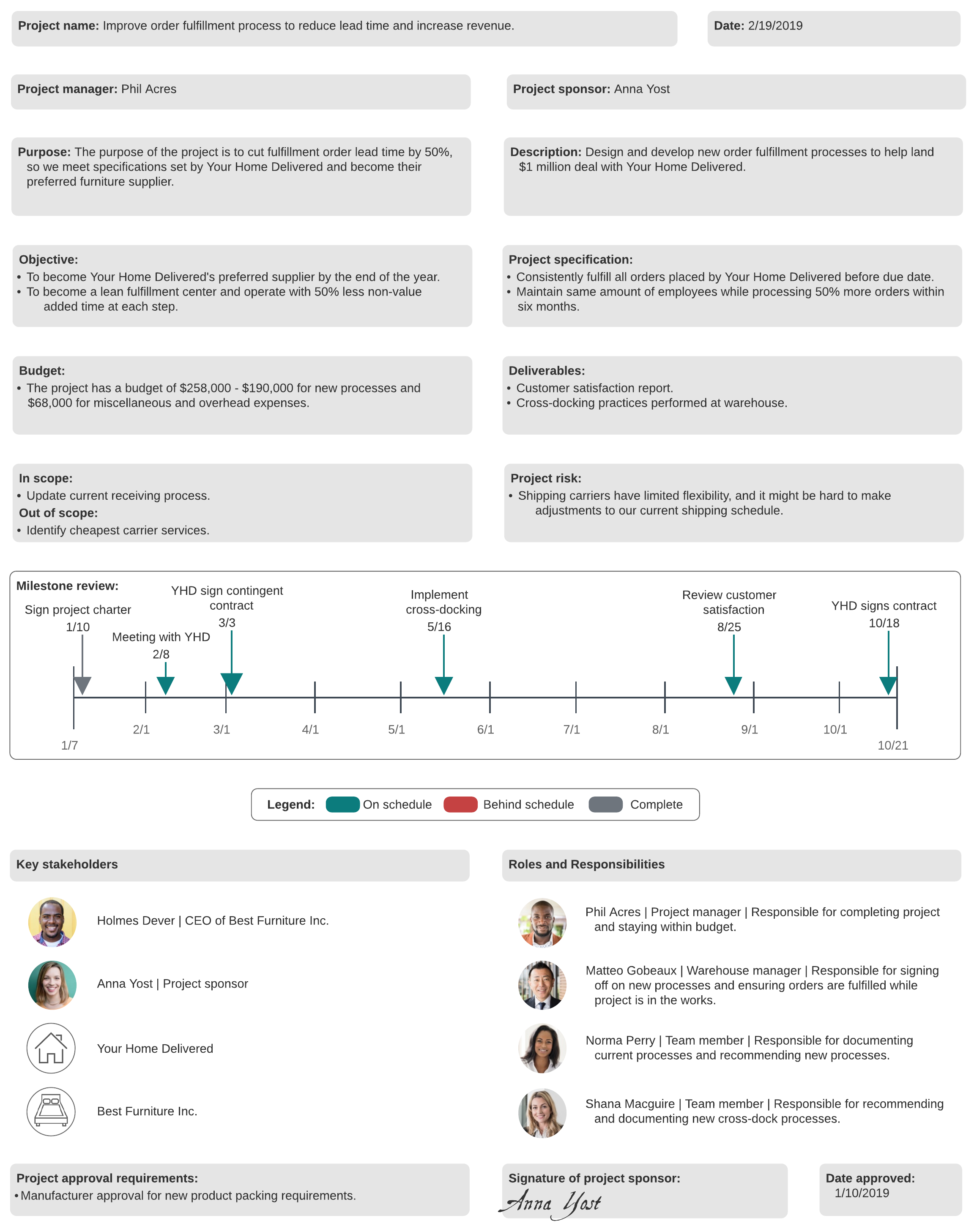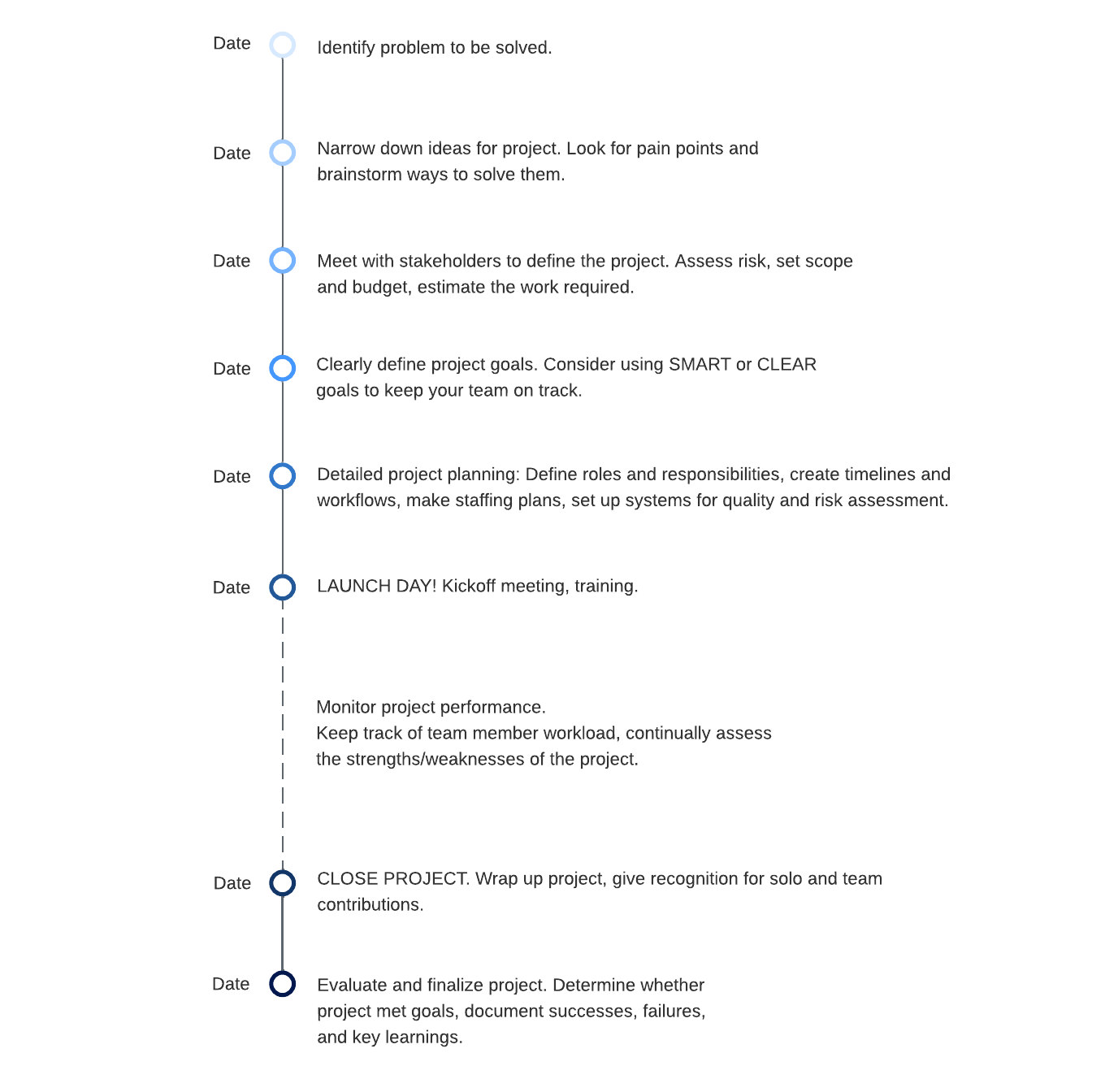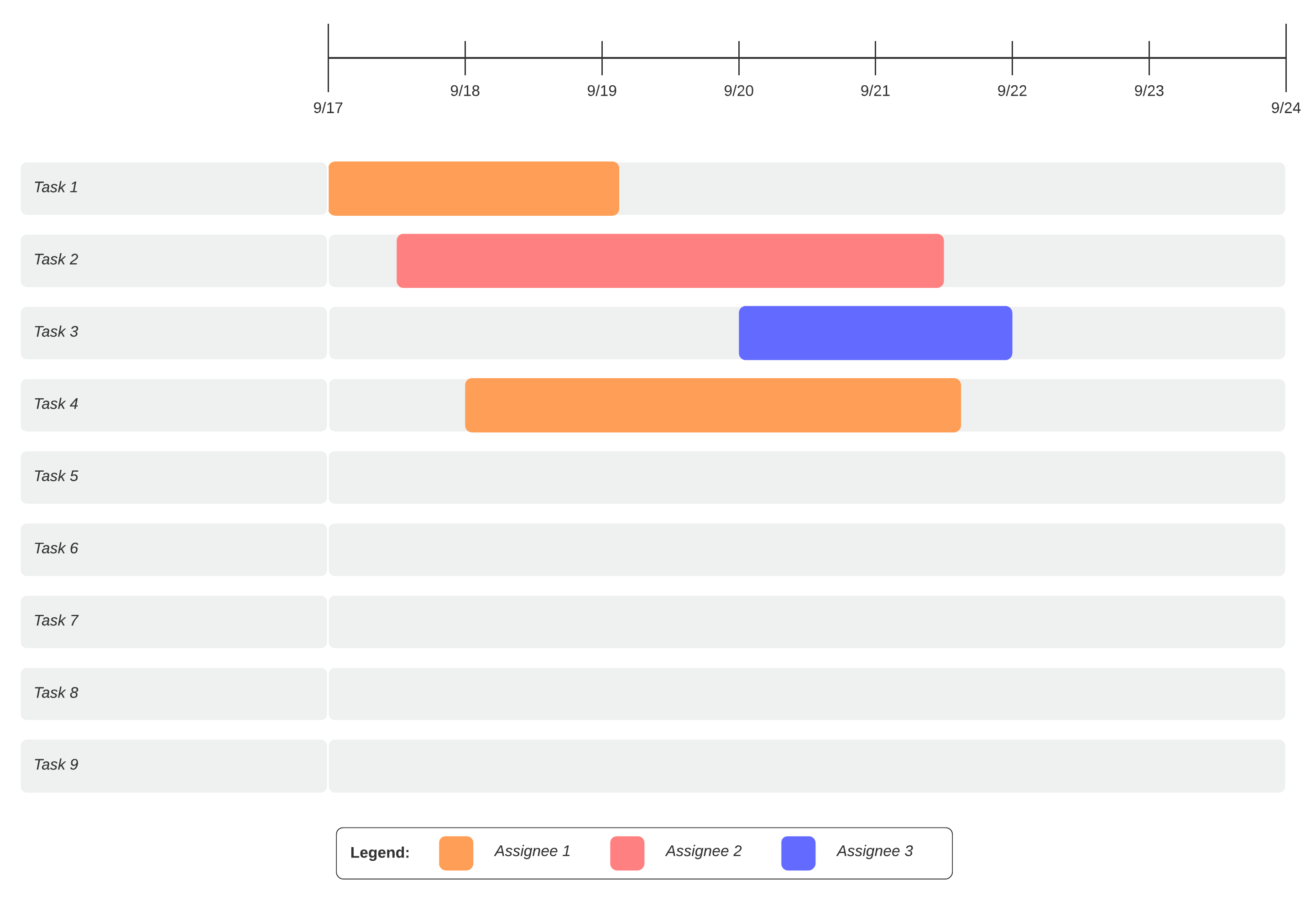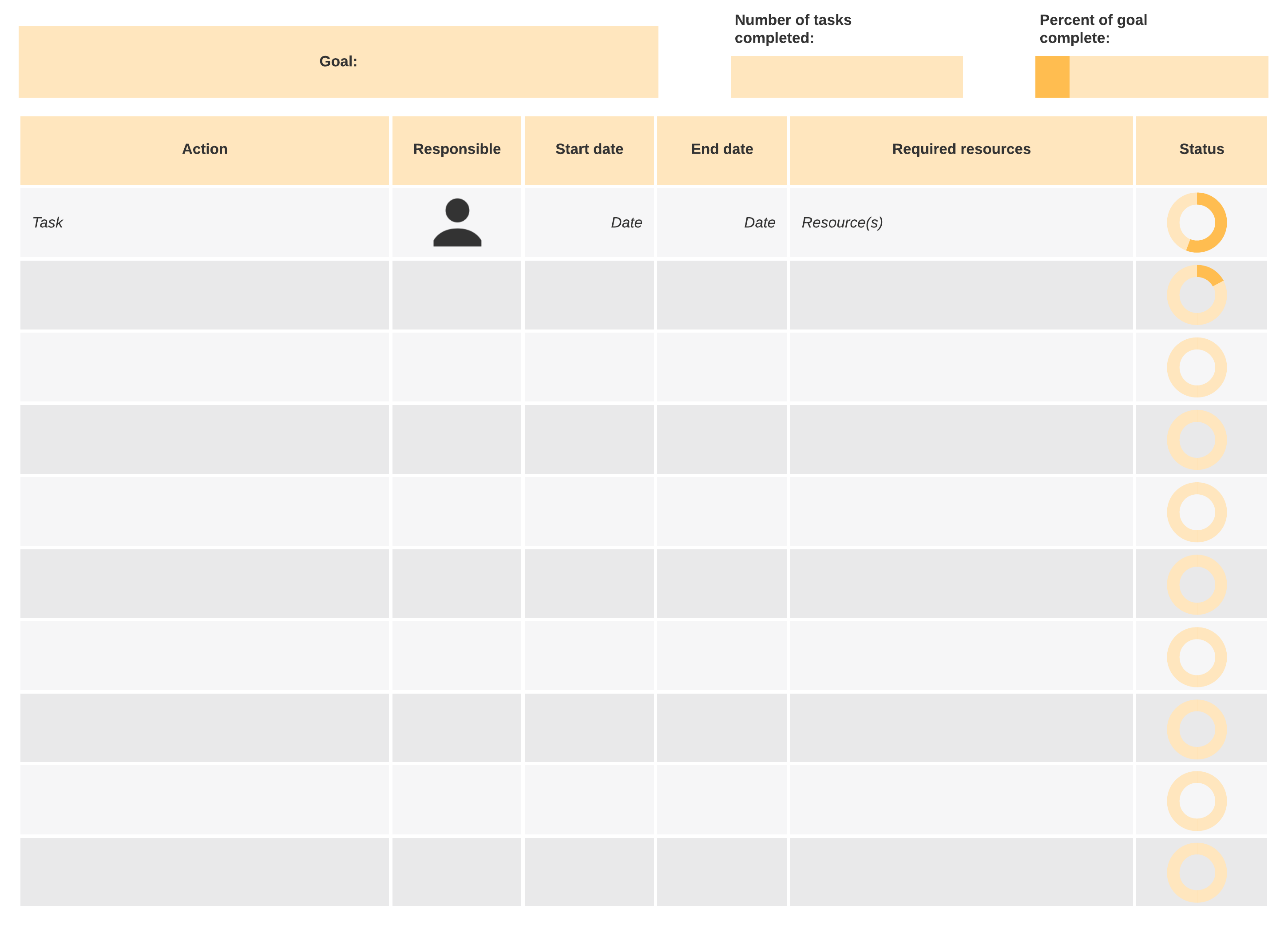What is a project charter in project management?
A project charter is a document that formalizes a project and gives the project manager authority over the project. Project charters act as a contract, holding everyone accountable for their roles and responsibilities.
If you work in operations or project management, you work tirelessly to establish the most efficient ways to accomplish tasks and maintain quality. However, before you can institute a new process or make significant changes to a current process, you need to get approval from stakeholders and get everyone else on board with your vision. You need a project charter.
As you put together your project charter contents, you’ll likely have questions, particularly if your company doesn’t offer a standard form or template to fill out. Find the answers to the most common questions below, and learn how to create a project charter that wows your stakeholders.
Steps to writing a project charter
- Choose a project name
- Identify the purpose, objective (goal), and project specification
- Set a budget
- Define deliverables
- Assess scope and risks
- Create a timeframe or milestones
- List key stakeholders
- Layout team roles and responsibilities

What is a project charter?
A project management charter states the scope and objectives of a project, as well as the people who will participate in it. You may also hear it called a project definition report or project statement. Project managers should use this document to:
- Authorize the project.
- Serve as a baseline throughout the project and provide shared understanding.
- Act as a contract, holding all participants accountable for their roles and responsibilities.
Your charter is the unquestionable source for details related to the project. It usually remains short but may link to more detailed documents.
Project charter vs. project plan
A project charter is a concise, high-level document outlining the basic goals and scope of the project. It serves as the foundation for your project plan, which goes into more detail on how to execute the objectives laid out in the charter. In other words, the project charter guides the project plan and execution.
How to write a project charter
If your organization doesn’t have a project charter template, you are free to include the information you find most beneficial. The more thorough your project charter, the more convincing it will be and the better a reference it’ll become. Every charter should include some variation on the following categories.
Project name
Name your project, and make the title as specific as you can. A project name like “HR Initiative” or “Software Update” doesn’t describe why you would like to implement this project and isn’t easy to differentiate from other project charters. Titles like “New Company Wellness Program” or “Software Update to Improve UX for Mobile Payments” define your goal right away.
Purpose, objective (goal), and project specification
These sections should present your business case and explain:
- Why the project was proposed, what pain points it will alleviate, and what impact it will have on the organization
- What the project will entail
- What you plan to accomplish with this project and how it fits in with larger organizational goals
- What needs to happen so it works and how it needs to perform
Budget
If you haven’t already done so earlier in the project charter, explain how much the project will cost and where the money will come from. This section could also list any additional resources needed to execute your plan.
Deliverables
What product, service, or result will you deliver when you finish the project? Since project charters are more flexible, you could include information in this section about your measurements for success in this project. How will you determine whether you have accomplished your goal? Which metrics will you use?
Scope and risks
Narrow your scope and mitigate risk from the very start of your project. The project charter should state known risks, constraints, and any plans for analyzing and managing risks throughout the project.

Get prepared by implementing a risk assessment process.
Read howTimeframe or milestones
Show when you plan to accomplish each stage of the project. The anticipated start and end dates are the most important pieces of information in this section, but a full timeline will give more context.

Learn more on how to incorporate milestones in your project management strategy.
Read nowLearn more on how to incorporate milestones in your project management strategy. Read now
Key stakeholders
While project charters are internal documents, you’ll likely be working with and report to external stakeholders, such as clients but also other project managers or teams in your company. Completing a stakeholder analysis and listing these individuals in the project charter keeps you and your team accountable to the people affected by the project.
Team roles and responsibilities
List the people involved in this project and their roles. Many project charter examples simply list the individual’s title or team, but if that information doesn’t define their responsibilities enough, you could reference a more specific document with the breakdown of responsibilities.

Ways to develop a project charter
Now that you understand what goes into a project charter, here is some additional direction to create a project charter with little hassle and with increased power to persuade and inform stakeholders.
Make it visual
Your stakeholders will read your document at least once, even if it merely contains a wall of text. However, images or design elements will make your defense stand out and make it easier for people to refer back to key parts of the documents later on.
Separate the different sections of your charter with boxes or accentuated headers for better readability. Then, see which parts of your document would be easier to scan or digest as a visual. For many project charters, the milestones section makes the most sense to convert.
Create a timeline or a Gantt chart in Lucidchart to show the milestones of your project. Take a look at our Gantt chart alternatives as well.


As mentioned previously, your project charter could also reference other documents. If it seems inappropriate to include your process flow or a breakdown of team responsibilities within the charter, build these diagrams separately and add a note or link.

Make it collaborative
You might need to print out your charter to present later, but while you put it together, keep this document in Google Drive or another program where multiple people can view and edit it. Then the teams who will see the largest impact from this project can put in their two cents before you present to other stakeholders.
Whatever format you choose, make sure to share your project charter with everyone who plays a significant role once you finalize and start your project.
When you add visuals using Lucidchart, you can take advantage of our integrations with Google, Atlassian, and Office 365. Download an add-on, and insert your diagrams seamlessly into your documents.
If you submit project charters frequently, consider these tips and put together your own project charter template!

Sign up for Lucidchart and start your project charter now.
Sign up freeAbout Lucidchart
Lucidchart, a cloud-based intelligent diagramming application, is a core component of Lucid Software's Visual Collaboration Suite. This intuitive, cloud-based solution empowers teams to collaborate in real-time to build flowcharts, mockups, UML diagrams, customer journey maps, and more. Lucidchart propels teams forward to build the future faster. Lucid is proud to serve top businesses around the world, including customers such as Google, GE, and NBC Universal, and 99% of the Fortune 500. Lucid partners with industry leaders, including Google, Atlassian, and Microsoft. Since its founding, Lucid has received numerous awards for its products, business, and workplace culture. For more information, visit lucidchart.com.
Related articles
How you can use Lucidchart to plan projects
Turn your ideas into real change when you use Lucidchart. We'll walk you through some key steps of scoping and planning a project and link to some helpful templates that will help you get started right away.
How to get the most out of projects with project planning
Project planning can help optimize work time to make more significant strides in your project journey. Learn how to create a project plan today.

